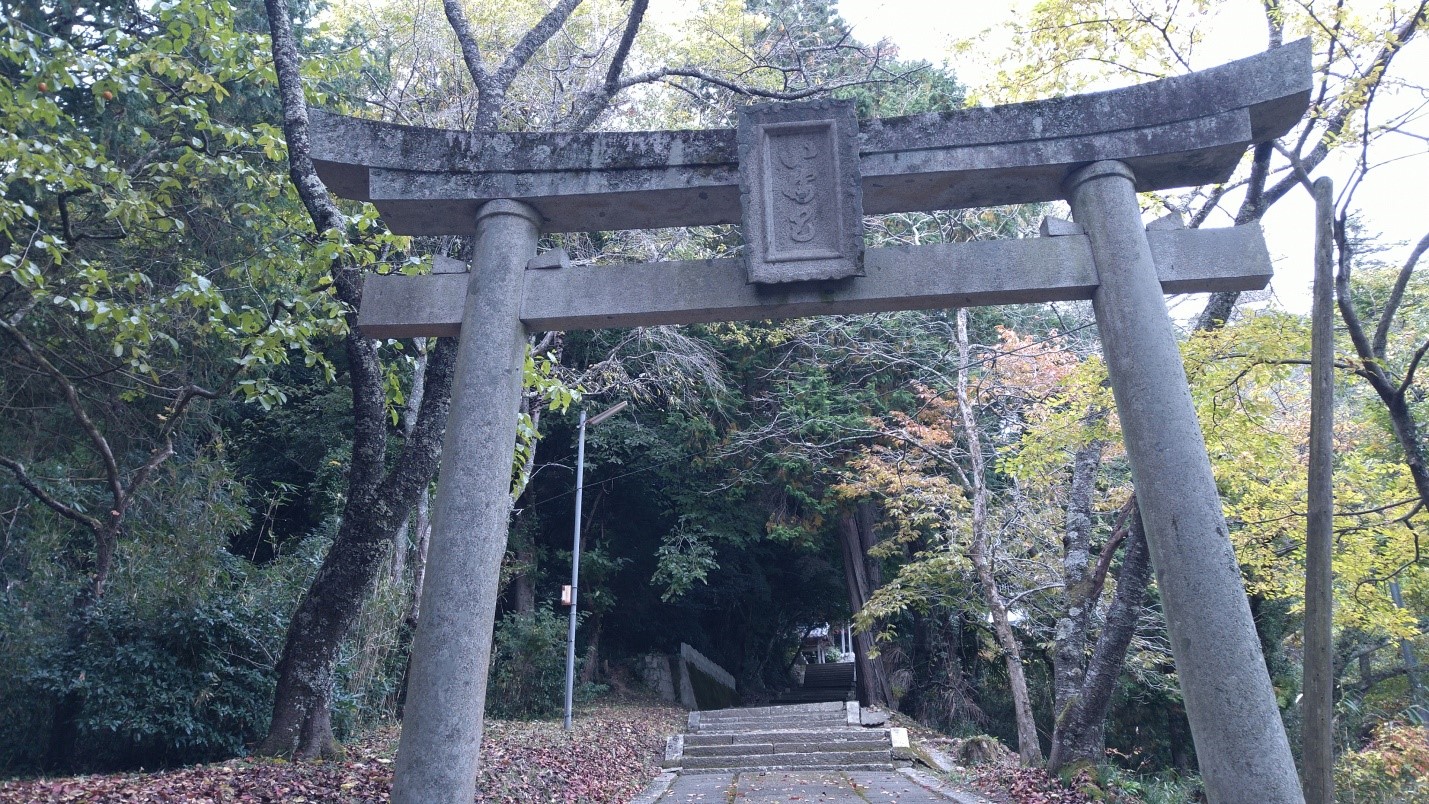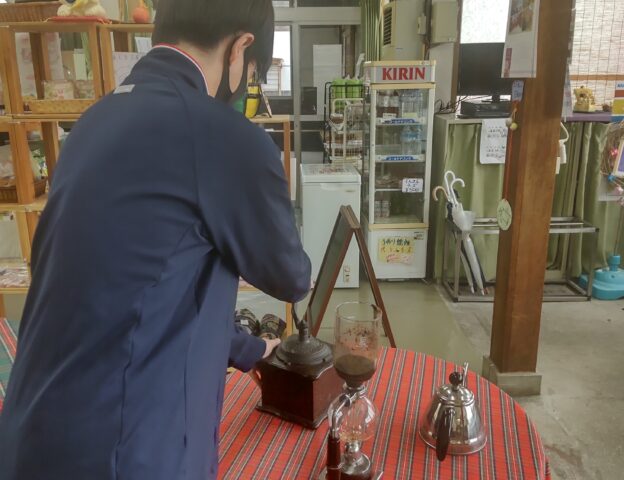Kakashi Festival
This month I arrived in Joge to quite the surprise. The New Prime Minister of Japan, Fumio Kishida, was visiting!

He was very easy to talk to, but a little stiff. Joking aside, Joge hosts a famous kakashi or scarecrow festival every year during the fall time.
This tradition dates back to early on in Joge’s history as it transitioned from a farming community to a merchant community. As fields and rice paddies began to disappear and be replaced with roads, shops, and houses the people of Joge found themselves with many left over scarecrows that “lost their jobs” so to speak. Feeling bad for these jobless scarecrows, locals began putting them back to work every harvest season by making interesting scenes of famous people or characters around the town. The creativity and effort always impresses me! Also, it makes for a fun photo opportunity.
This year Kimetsu no Yaiba or Demon Slayer characters were very popular.

When visiting in the fall you can enjoy looking for these cute kakashi and then vote for your favorite. I wonder who will win this year?

While the scarecrows show off their new jobs, the trees also show off their new colors this time of year. After taking pictures of kakashi scenes and placing my secret vote, I took a short hike to Joge Kameyama Hachiman Shrine in search of the quiet beauty of Joge’s mountain momiji. Momiji is the Japanese word for maple leaves and in early fall, momiji turn bright red.


Kameyama Hachiman Shrine was first built in 1327 and then in 1927 it was restored and given special rank. The shrine complex sits at the top of a small hill with easy to climb stairs. It is located about 10 minutes away from the town center.

Japanese Shinto Shrines are quiet places to feel connected with nature and reflect on life. Here you can see a red-roofed kamidana or spirit house resting serenely as red maple leaves fall gently in the waiting reflection pool. At the main shrine you can ring a bell and offer small change to make prayers for a happy life.

Although Shinto is a native Japanese religion, all are welcome and encouraged to self-reflect or make a prayer. If you choose to participate or watch respectfully either way you are sure to feel enveloped in the autumn atmosphere and beautiful traditional architecture.

Viewing the colorful leaves and considering the changing seasons is an important part of the fall experience. Sitting under the golden scarlet curtain of nature while listening for the call of the quietly coming winter winds, you can feel the power of the Kameyama Shrine’s almost 700 year history.

After reflecting on the past, my mind often wanders back to thoughts on the future. What might happen next? How will we address the many difficult social and ecological problems that continue to build with each passing year?
I found that I was not alone in these thoughts, as many Joge residents expressed worry over how late the leaves are changing this year due to the warm weather. If things keep heating up like this beautiful fall mountain scenes may become a thing of the past!
As I walked back to the center of town from the shrine, thinking these heavy thoughts, I noticed a rather strange sign:

An electric vehicle (EV) charging station? Car sharing?
These days, with talk of SDGs (Sustainable Development Goals) and businesses racing to perfect hybrid, electric and even self-driving cars, such a thing may not be very surprising in a large city, but in a small Japanese country town? I had to find out more!
Searching the sign’s information online I soon found I was another 10 minute walk away from Hotta Ringyo, a vehicle servicing and sales business in Joge. Admittedly, I was a little nervous to come in unannounced asking about electric cars, but to my surprise the owner, a Mr. Teppei, greeted me with a friendly “good afternoon” in English as I came in the door. He was more than happy to sit down and explain to me what exactly EV stations are doing all the way out here in such a rustic setting.

Teppei explained, “Joge has an electric car sharing system to help improve community life and make a stronger future.” His electric car sharing system also called Sato-Yama car sharing originated from a Swiss idea. In Switzerland a group of university students discovered they could meet their transportation needs while simultaneously reducing carbon emission through developing a car sharing system. After some trial and error the students discovered that as few as 3 cars could accommodate the travel and daily errands of about 10 people!
Teppei’s system began in 2010 and now has about 700 people enrolled in car sharing. The idea may seem strange at first, but after signing up I discovered the system was not so difficult. In order to ensure two or more people do not simultaneously need the electric car, reservations are made digitally and can be done from the convenience of your smartphone.
The electric cars themselves are placed strategically around Joge Town and after reservation can be unlocked by a special magnetic card, received after signing up for the program. They are great for short trips around the town or to see sites that may be difficult to get to on foot.
As the cars are 100 % electric the payment fees are primarily based on rental time. Not including the small sign up fees for joining the program, borrowing an electric car for 15 minutes will only cost about 220 yen. While borrowing for 24 hours will cost a little more, about 7,150 yen. This is much cheaper than renting a large traditional gasoline consuming car!
It is Teppei’s hope that through encouraging sustainable alternatives and building a sense of community, human beings will be more conscious of their impact on the world and the people they live alongside.

For those visitors who are very interested in sustainable transportation but may not have an international driver’s license, please don’t worry there is another way!
Just like in larger cities around the world, Joge’s Tenryo Guest House also offers rental bikes that you can borrow during your stay, making your trips to shrines, restaurants, and local events even faster.

The bikes don’t require any previous reservation or license and only cost 100 yen to take out for the day!
If more communities offered sustainable travel alternatives, like Joge, then pollution could be reduced. For the sake of natural beauty and those cute hardworking kakashi, we should try using new ideas like rental bikes and car sharing to help do our part and create a cleaner future.
Until next time, stay well and stay green.
For more information in English on transportation around Joge town or planning your own future tour of Kameyama Hachiman Shrine please contact me at thometeach@gmail.com
<和訳>
かかし祭り
上下に着いてびっくりしました・・・岸田文雄新総理がいらしてたんですよ!
話しかけやすかったのですが、じっとしたままで・・・まぁ、冗談はさておき、上下町では毎年秋になると「かかし祭り」が開催されます。
この祭りは上下の産業が農業から商業へと移行していった頃に始まったそうです。畑や田んぼが道路や商業施設、住宅へと置きかわり、あとにはいわゆる「失業」したかかしたちが残されたというわけなんです。
かかしたちが可哀そうだと感じた町の人たちは、毎年収穫シーズンになると町内のいたるところに有名人やキャラクターを模したかかしたちを飾り、再び活躍してもらうことにしたのです。
独創性と頑張りにはいつも感心させられます!写真もたくさん写したくなりますよ!
今年は『鬼滅の刃(Damon Slayer)』のキャラクターが大人気でした。
秋に訪れるとこんなキュートなかかしを探して楽しんだり、お気に入りのかかしに投票ができるんです。今年は誰が受賞するのかな?
かかしの写真を撮り投票を済ませてから、静かなところできれいなモミジを見たくて上下亀山八幡神社まで歩いてみました。
Momiji(モミジ)はMaple(カエデ)の和語で初秋に赤く色づきます。
亀山八幡神社は1327年に遷座(せんざ)、1927年に修復後「郷社(ごうしゃ)」に昇格しました。神殿は小高い丘の上にあり、昇りやすい階段があります。町中からは10分ほどのところにあります。
日本の神社は自然との一体感を感じたり、人生に思いを馳せたりできるようにと静かな場所にあります。
赤い屋根の神棚(精舎)が色づいた紅葉の舞い散った池に映って、まるで穏やかに休んでいるようですよね。本殿では鐘を鳴らして気持ちばかりのお賽銭を供えて幸せを祈ります。
神道は日本独自の宗教ですが、自分を見つめなおしたり祈りを捧げたりとだれでもお参りできるのです。謙虚な気持ちでお参りをすれば、きっと「秋」と美しく伝統的な建物に包まれているって感じられることでしょう。
秋に色とりどりの木の葉を観たり、季節の移ろいに思いを馳せることができるってとても大切なことですよね。見事な緋色のカーテンの下に腰を下ろし、静かに近づきつつある冬の風音が聞こえてこないかなと耳を澄ませていると、700年近い歴史がもたらす亀山八幡神社のパワーを感じられますよ。
過去を省みたあとは未来へと思いが切り替わることがよくあります。
次に起こることは何?年々増え続ける社会や環境への難題にどう取り組んでいくのでしょうか?
こう思うのは私だけではないようで、上下の人たちも、今年も温暖化で葉の色づきが遅くなったと話していました。このまま気温の上昇が続けば、この美しい秋の山も過去のものになるかもしれません!
こんな気重なことを考えながら神社から町の中へと戻ると、ちょっと見かけない看板に気付きました。
電気自動車(EV)充電ステーション?カーシェアリング?
近頃、SDGs (Sustainable Development Goals 持続可能な開発目標)や電気とエンジン併用車のようにハイブリッド化を競うビジネスは大都市では珍しくありませんが、なぜ小さな日本の田舎町に?
看板の案内から、町内で自動車の点検・販売をしている堀田輪業から歩いて10分ほどのところにいることがわかりました。
いきなり電気自動車のことを訊きに入るのは少し緊張しましたが、驚いたことにオーナーのてっぺい氏は店内に入る私に優しく“Good Afternoon(こんにちは)”と英語で声をかけてくださいました。
彼は腰を下ろし、むしろ嬉しそうになぜこんな田舎でEV stations (充電スタンド) を設置してきたのか経緯を説明してくださったのです。
「より暮らしやすい地域・踏ん張れる力を備えた未来のために上下に電気自動車のカーシェアリングがあるんですよ」と、てっぺいさんは話してくださいました。
里山カーシェアリングとも呼ばれていて、そのシステムはスイス発祥のものだそうです。
スイスのある大学生グループがカーシェアリングシステムを開発すれば二酸化炭素の排出量を減らせ、同時に自分たちの移動手段もかなうことに気づいたのです。
試行錯誤のの末、10人分の旅行や日常使いなら3台の自動車があれば間に合うことを発見しました!
てっぺいさんのカーシェアリングシステムは2010年開始で、現在登録者数は約700名です。初めは慣れない感じでしたが、登録してみるとそんなに難しいシステムではないことがわかりました。予約は2名以上が同時に申し込めないようにデジタル化されていて、スマートフォンからもできるので便利です。
電気自動車は町内に設置されていて予約が通ると登録後に受け取った専用磁気カードで鍵が開くようになっています。周辺への短い旅行や徒歩では行けない場所を観たりするのには最適です。
100%電動なので料金は基本的に借りた時間に順じます。少額の登録費用を除き、15分借りるとわずか220円。24時間借りると約7150円です。大型のガソリン車を借りるよりずっと安くつきますね!
環境に優しい手段を推奨すること、コミュニティ意識を作り上げていくことを通して人類が今以上に自分自身の存在価値に気づくことができる・・・それがてっぺいさんの願いなのです。
環境に配慮した移動手段に興味はあるけど国際免許は持てないって方、ご安心ください、いい手がありますよ!
世界中の都市同様に、ゲストハウス「泊まれる町家 天領上下」にも貸し自転車があります、神社へ、レストランへ、イベントへと時短で移動できますね
事前予約も免許も不要で一日借りても料金は100円です!
上下のように、もっと多くの地域で環境に優しい旅ができれば環境汚染も減るだろうと思います。美しい自然を残すため、そして頑張ってる案山子(かかし)たちのためにも貸し自転車やカーシェアリングなどのような新しいことを試してみるべきだと思います。そうすればもっとクリーンな未来が築けると思うのです。
それでは次回まで、どうぞお元気で!
上下周辺の乗り物の情報や亀山八幡神社への情報を英語でご希望の方は私までお問合せください。
筆者と編集者のプロフィール
Matt Thome(マット=トーミ)とSage Panter(セイジ=パーンタ)
2018年より広島県に在住。二人とも日本の伝統文化や新しいことを試すのが大好きです。
もっと思いやりにあふれ、ワクワクする国際社会の実現をめざして英語教育・平和活動・国際観光事業の分野にも従事しています。







